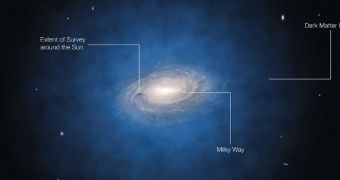One of the largest investigations of the solar neighborhood has revealed no signs of dark matter, the stuff believed to interact with baryonic matter exclusively through the force of gravity. These results are a serious problem to the current models explaining the distribution of dark matter.
According to predictions, the region around the Sun should have been filled with dark matter. But scientists used the 2.2-meter MPG/ESO telescope the European Southern Observatory operates at Las Silla, Chile, and found no signs of the stuff within 13,000 light-years of the Sun.
The study was conducted by measuring the velocities of 400 stars with extreme accuracy. By studying the influences these objects suffered as they traveled through space, experts were able to calculate the mass present in this bubble around the Sun.
“The amount of mass that we derive matches very well with what we see – stars, dust and gas. But this leaves no room for […] the dark matter that we were expecting. Our calculations show that it should have shown up very clearly in our measurements. But it was just not there!” team leader Christian Moni Bidin explains.

 14 DAY TRIAL //
14 DAY TRIAL //